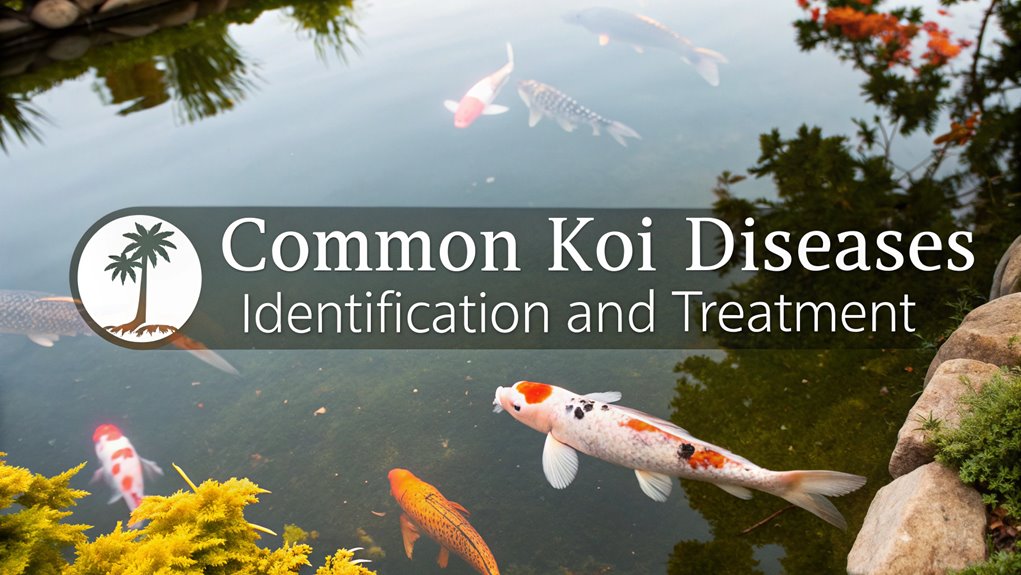To diagnose common koi diseases, monitor for symptoms like erratic swimming, swollen abdomens, or white spots. Conduct regular skin scrapes and water tests to identify parasites, bacteria, and water quality issues. Treatment varies: physical removal for anchor worms and antibiotics for fin rot. Quarantining sick fish is essential. Observing behavior and using a Koi Health Checklist aids in early detection. There’s more to explore for effective koi disease management.
TLDR
- Poor water quality and overcrowding increase the risk of koi diseases.
- Symptoms include erratic swimming, swollen abdomens, and loss of appetite.
- Common diseases: Ich, Dropsy, Fin Rot, Mouth Rot, and Flukes.
- Diagnostic methods include skin scrapes and water quality tests.
- Treatments involve quarantine, antibiotics, and broad-spectrum medications.
Causes of Koi Diseases
Although koi are resilient fish, their health can rapidly decline due to several identifiable causes.
Poor water quality is a critical factor, often leading to stress and subsequent diseases. Contaminants such as pesticides can compromise water quality, making koi vulnerable to parasites and other common koi diseases.
Additionally, environmental changes, like sudden temperature drops, can weaken their immune systems. You should also consider the risks of overcrowding, which exacerbates stress and increases the likelihood of sick koi.
Introducing new fish without proper quarantine can spread diseases among otherwise healthy koi. Spawning activities may further stress the fish, triggering territorial aggression and potential disease outbreaks.
Maintaining ideal water quality and diligent monitoring for signs of disease are essential preventative measures.
Symptoms and Signs to Watch For
How can you detect early signs of health issues in your koi fish?
Watch closely for behavioral shifts and external signs in your pond. White spots often indicate common diseases like Ich, while a loss of appetite can signal stress or infection.
If your koi are gasping for air at the water’s surface, it may hint at respiratory problems, often linked to parasites or poor water quality. Clamped fins are another red flag.
Keep an eye out for:
- Behavioral Changes: Isolation or erratic swimming may suggest a health issue.
- Physical Symptoms: Look for swollen abdomens, ulcers, or cloudy eyes.
- Respiratory Distress: Gasping for air indicates potential respiratory complications.
Prompt identification of these symptoms can aid in the early diagnosis and treatment of koi health issues.
Common Koi Diseases Explained
Identifying and understanding common koi diseases is essential for maintaining their health and longevity.
Ichthyophthirius multifiliis, commonly known as Ich, manifests as small white spots on koi, requiring prompt treatment to avoid severe complications.
Dropsy, often due to bacterial infections or parasites, leads to bloating and protruding scales, and can be fatal if not treated swiftly.
Fin Rot, resulting from bacterial infections, causes frayed fins and discoloration, necessitating immediate intervention to prevent permanent damage.
Mouth Rot presents with redness and swelling, potentially escalating into secondary infections if untreated.
Flukes, parasitic attackers of gills, impair breathing and induce scratching behaviors.
Regular water changes and targeted treatment can mitigate these Koi Fish Diseases, ensuring your koi don’t fall sick.
Diagnostic Techniques for Identifying Koi Diseases
Recognizing common koi diseases is only the first step in ensuring their health. To accurately diagnose these issues, employ a systematic approach. Conduct skin scrapes to identify parasites and bacteria under a microscope.
Observe any behavioral changes—erratic swimming or isolation can indicate health concerns. A visual examination reveals physical symptoms like white spots or frayed fins, common in diseases such as Ich or Fin Rot.
Regular water quality tests, focusing on pH, ammonia, and nitrite levels, help correlate environmental stressors with potential health issues. Use a Koi Health Checklist to streamline the assessment process by prompting key evaluations.
- Skin scrapes: Detect parasites and bacteria.
- Behavioral changes: Note erratic swimming or isolation.
- Visual examination: Identify physical disease signs.
Treatment Options for Koi Diseases
While addressing koi diseases, employing targeted treatment strategies is vital to effective recovery. You should start by identifying the disease, as treatment options vary.
For Common Koi Fish plagued by parasites like anchor worms, physical removal coupled with rubbing alcohol application can expedite healing. Broad-spectrum medications, such as Parazoryne for Ich, target specific parasitic infestations.
In cases of bacterial infections like fin rot, antibiotics become essential. Enhancing water quality is important to boost koi immune responses, reducing the likelihood of further complications.
Implement quarantine procedures by isolating sick koi in a separate tank to prevent disease spread. Regular monitoring and adjusting treatments based on symptoms observed can greatly improve recovery rates, ensuring healthier koi in your care.
Preventive Measures for Maintaining Koi Health
After establishing effective treatment protocols for koi diseases, it’s essential to focus on prevention to maintain a healthy pond environment.
One vital step is to quarantine new fish for at least 30 days, as this is a highly recommended preventive measure to avoid introducing diseases caused by parasites.
It’s important to regularly test your pond’s water quality to maintain ideal pH and water temperature, which are sure signs of a stable ecosystem.
Avoid overcrowding, as it can stress koi and lead to outbreaks. Properly feed your koi without overfeeding to prevent waste accumulation.
- Implement effective filtration systems: This helps maintain clean water, reducing disease risk.
- Regularly test water quality: Guarantees a balanced pond environment.
- Quarantine new fish: Prevents spreading potential diseases.
Monitoring and Maintenance Practices for Koi Ponds
Effective monitoring and maintenance practices are critical for ensuring a healthy koi pond ecosystem. Regularly test water parameters, including pH, ammonia, nitrite, and nitrate levels, to maintain stable water quality and prevent health issues in fish.
Weekly maintenance should include cleaning filters, removing debris, and performing partial water changes to optimize conditions. Monitoring koi population density is essential to avoid overcrowding, which can stress fish and increase disease susceptibility.
Implement a quarantine procedure for new fish, isolating them for at least 30 days to prevent disease introduction. Inspect koi regularly for signs of illness, such as behavioral changes or physical symptoms like lesions or abnormal swimming patterns, allowing for early diagnosis and intervention in potential health issues.
Frequently Asked Questions
What Is the Most Common Disease in Koi Fish?
You’re likely dealing with White Spot Disease (Ich) in koi, a parasitic infection marked by white spots on skin and fins. Rapid treatment is essential, involving temperature adjustments and medication to eradicate the Ichthyophthirius multifiliis parasite.
What Does Ich Look Like on Koi?
Imagine a starry night reflected on koi skin; that’s Ich. Look for 0.1-millimeter white spots clustering on their body and fins. You’ll notice rapid gill movement and rubbing against surfaces, indicating irritation from Ichthyophthirius multifiliis.
What Are the Symptoms of a Bacterial Infection in a Koi?
You’ll notice symptoms like redness, swelling, or lesions around the mouth, increased mucus, frayed fins, or ulcers. Koi may become lethargic, lose appetite, swim poorly, and in severe cases, display dropsy. Immediate antibiotic treatment’s essential.
What Does Fungus Look Like on Koi Fish?
You’ll notice fungus on koi fish as white, cotton-like patches on skin, fins, or gills. These indicate Saprolegnia infection. Check for underlying issues like water quality, injuries, or immunity problems to initiate effective antifungal treatments.
Conclusion
You’ve now got the keys to reveal the mysteries of koi health. By recognizing symptoms and employing diagnostic techniques, you can tackle diseases head-on, like a seasoned detective unraveling a complex case. Treatment options are your arsenal, ready to restore your koi’s vigor. Prevention is your fortress; fortify it with diligent monitoring and maintenance. In this intricate dance of care, your koi’s well-being is the symphony, and you’re the maestro orchestrating a harmonious aquatic haven.

